NUR1201 Essay: Reflecting on Patient Care for Improved Outcomes
VerifiedAdded on 2022/10/02
|9
|2151
|115
Essay
AI Summary
This essay, prepared for the NUR1201 course, explores the application of Gibbs' Six Stages of reflection to improve healthcare practice, particularly for newly graduated nurses. The essay centers on a case scenario involving William Taylor, a patient with multiple health conditions, and evaluates the quality of care he received. It highlights the importance of patient-centered interventions, adherence to nursing standards, and care partnerships in achieving positive patient outcomes. The analysis emphasizes the significance of patient involvement in decision-making, comprehensive diagnosis, and the impact of practitioner attitudes on patient satisfaction. The essay concludes by advocating for continuous reflection on patient encounters to improve professional skills and ensure that healthcare professionals prioritize patient-centered and collaborative approaches to care delivery. The essay references several scholarly articles to support its arguments.

Running head: NUR1201 1
Nur1201
Student’s Name
Institutional Affiliation
Nur1201
Student’s Name
Institutional Affiliation
Paraphrase This Document
Need a fresh take? Get an instant paraphrase of this document with our AI Paraphraser
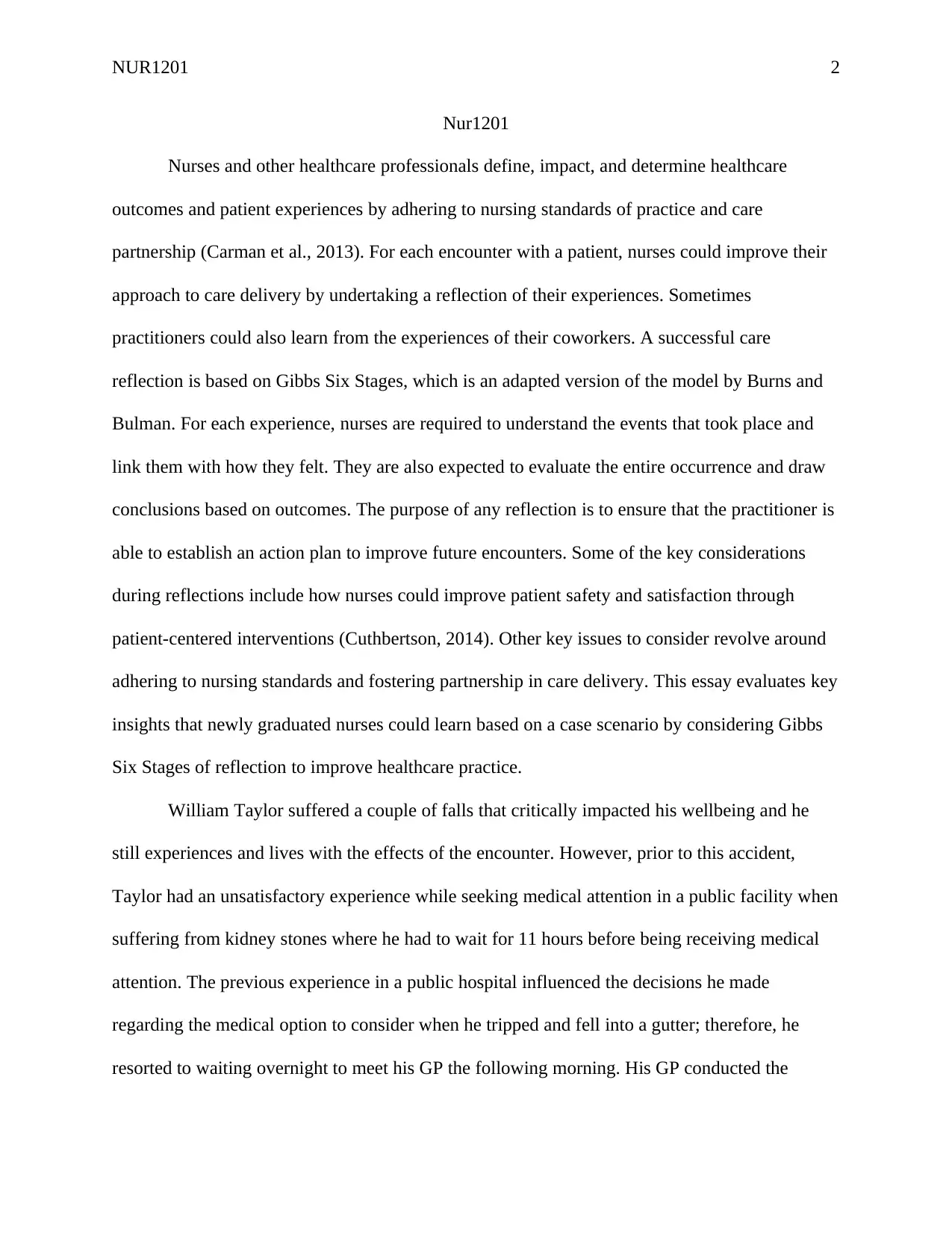
NUR1201 2
Nur1201
Nurses and other healthcare professionals define, impact, and determine healthcare
outcomes and patient experiences by adhering to nursing standards of practice and care
partnership (Carman et al., 2013). For each encounter with a patient, nurses could improve their
approach to care delivery by undertaking a reflection of their experiences. Sometimes
practitioners could also learn from the experiences of their coworkers. A successful care
reflection is based on Gibbs Six Stages, which is an adapted version of the model by Burns and
Bulman. For each experience, nurses are required to understand the events that took place and
link them with how they felt. They are also expected to evaluate the entire occurrence and draw
conclusions based on outcomes. The purpose of any reflection is to ensure that the practitioner is
able to establish an action plan to improve future encounters. Some of the key considerations
during reflections include how nurses could improve patient safety and satisfaction through
patient-centered interventions (Cuthbertson, 2014). Other key issues to consider revolve around
adhering to nursing standards and fostering partnership in care delivery. This essay evaluates key
insights that newly graduated nurses could learn based on a case scenario by considering Gibbs
Six Stages of reflection to improve healthcare practice.
William Taylor suffered a couple of falls that critically impacted his wellbeing and he
still experiences and lives with the effects of the encounter. However, prior to this accident,
Taylor had an unsatisfactory experience while seeking medical attention in a public facility when
suffering from kidney stones where he had to wait for 11 hours before being receiving medical
attention. The previous experience in a public hospital influenced the decisions he made
regarding the medical option to consider when he tripped and fell into a gutter; therefore, he
resorted to waiting overnight to meet his GP the following morning. His GP conducted the
Nur1201
Nurses and other healthcare professionals define, impact, and determine healthcare
outcomes and patient experiences by adhering to nursing standards of practice and care
partnership (Carman et al., 2013). For each encounter with a patient, nurses could improve their
approach to care delivery by undertaking a reflection of their experiences. Sometimes
practitioners could also learn from the experiences of their coworkers. A successful care
reflection is based on Gibbs Six Stages, which is an adapted version of the model by Burns and
Bulman. For each experience, nurses are required to understand the events that took place and
link them with how they felt. They are also expected to evaluate the entire occurrence and draw
conclusions based on outcomes. The purpose of any reflection is to ensure that the practitioner is
able to establish an action plan to improve future encounters. Some of the key considerations
during reflections include how nurses could improve patient safety and satisfaction through
patient-centered interventions (Cuthbertson, 2014). Other key issues to consider revolve around
adhering to nursing standards and fostering partnership in care delivery. This essay evaluates key
insights that newly graduated nurses could learn based on a case scenario by considering Gibbs
Six Stages of reflection to improve healthcare practice.
William Taylor suffered a couple of falls that critically impacted his wellbeing and he
still experiences and lives with the effects of the encounter. However, prior to this accident,
Taylor had an unsatisfactory experience while seeking medical attention in a public facility when
suffering from kidney stones where he had to wait for 11 hours before being receiving medical
attention. The previous experience in a public hospital influenced the decisions he made
regarding the medical option to consider when he tripped and fell into a gutter; therefore, he
resorted to waiting overnight to meet his GP the following morning. His GP conducted the
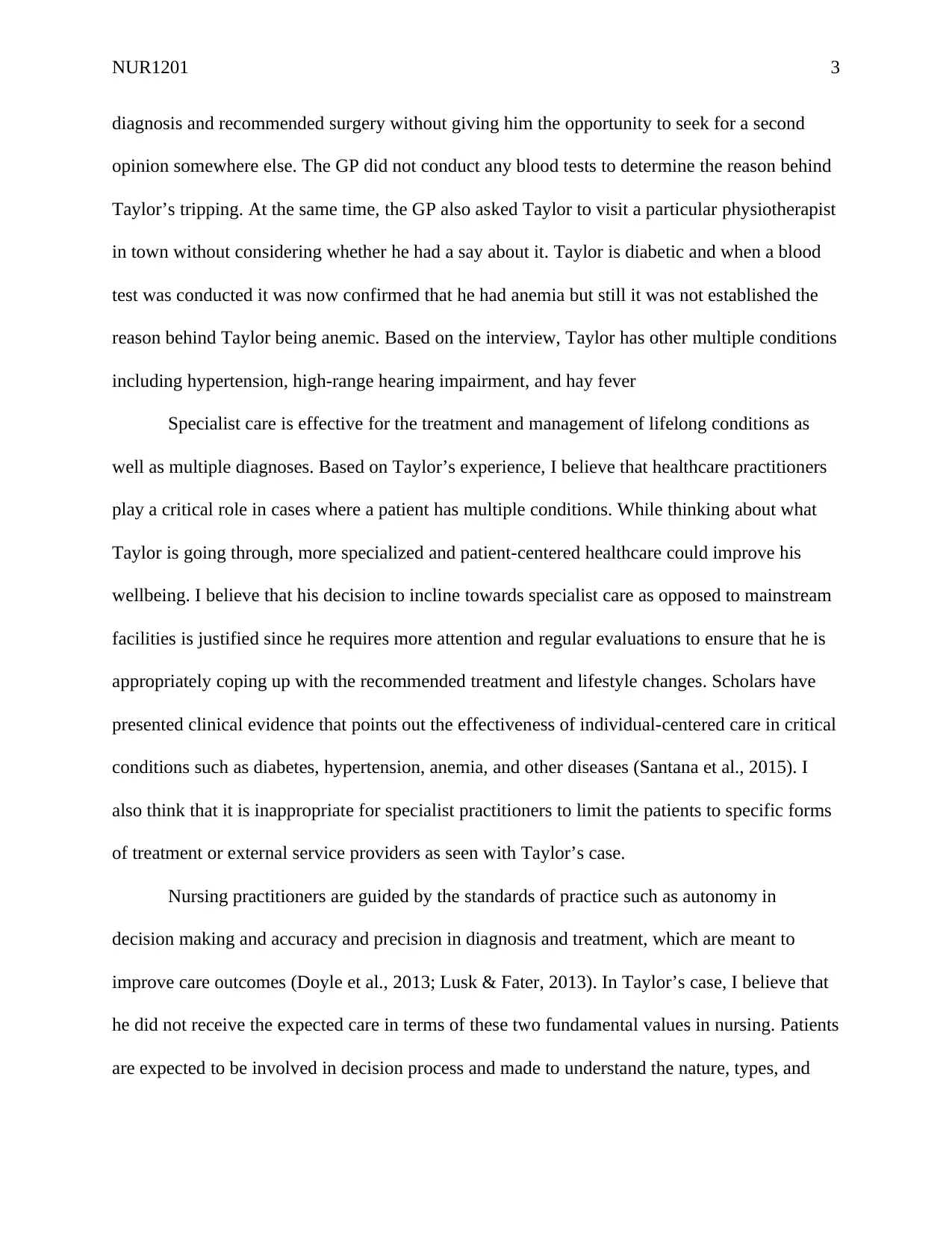
NUR1201 3
diagnosis and recommended surgery without giving him the opportunity to seek for a second
opinion somewhere else. The GP did not conduct any blood tests to determine the reason behind
Taylor’s tripping. At the same time, the GP also asked Taylor to visit a particular physiotherapist
in town without considering whether he had a say about it. Taylor is diabetic and when a blood
test was conducted it was now confirmed that he had anemia but still it was not established the
reason behind Taylor being anemic. Based on the interview, Taylor has other multiple conditions
including hypertension, high-range hearing impairment, and hay fever
Specialist care is effective for the treatment and management of lifelong conditions as
well as multiple diagnoses. Based on Taylor’s experience, I believe that healthcare practitioners
play a critical role in cases where a patient has multiple conditions. While thinking about what
Taylor is going through, more specialized and patient-centered healthcare could improve his
wellbeing. I believe that his decision to incline towards specialist care as opposed to mainstream
facilities is justified since he requires more attention and regular evaluations to ensure that he is
appropriately coping up with the recommended treatment and lifestyle changes. Scholars have
presented clinical evidence that points out the effectiveness of individual-centered care in critical
conditions such as diabetes, hypertension, anemia, and other diseases (Santana et al., 2015). I
also think that it is inappropriate for specialist practitioners to limit the patients to specific forms
of treatment or external service providers as seen with Taylor’s case.
Nursing practitioners are guided by the standards of practice such as autonomy in
decision making and accuracy and precision in diagnosis and treatment, which are meant to
improve care outcomes (Doyle et al., 2013; Lusk & Fater, 2013). In Taylor’s case, I believe that
he did not receive the expected care in terms of these two fundamental values in nursing. Patients
are expected to be involved in decision process and made to understand the nature, types, and
diagnosis and recommended surgery without giving him the opportunity to seek for a second
opinion somewhere else. The GP did not conduct any blood tests to determine the reason behind
Taylor’s tripping. At the same time, the GP also asked Taylor to visit a particular physiotherapist
in town without considering whether he had a say about it. Taylor is diabetic and when a blood
test was conducted it was now confirmed that he had anemia but still it was not established the
reason behind Taylor being anemic. Based on the interview, Taylor has other multiple conditions
including hypertension, high-range hearing impairment, and hay fever
Specialist care is effective for the treatment and management of lifelong conditions as
well as multiple diagnoses. Based on Taylor’s experience, I believe that healthcare practitioners
play a critical role in cases where a patient has multiple conditions. While thinking about what
Taylor is going through, more specialized and patient-centered healthcare could improve his
wellbeing. I believe that his decision to incline towards specialist care as opposed to mainstream
facilities is justified since he requires more attention and regular evaluations to ensure that he is
appropriately coping up with the recommended treatment and lifestyle changes. Scholars have
presented clinical evidence that points out the effectiveness of individual-centered care in critical
conditions such as diabetes, hypertension, anemia, and other diseases (Santana et al., 2015). I
also think that it is inappropriate for specialist practitioners to limit the patients to specific forms
of treatment or external service providers as seen with Taylor’s case.
Nursing practitioners are guided by the standards of practice such as autonomy in
decision making and accuracy and precision in diagnosis and treatment, which are meant to
improve care outcomes (Doyle et al., 2013; Lusk & Fater, 2013). In Taylor’s case, I believe that
he did not receive the expected care in terms of these two fundamental values in nursing. Patients
are expected to be involved in decision process and made to understand the nature, types, and
⊘ This is a preview!⊘
Do you want full access?
Subscribe today to unlock all pages.

Trusted by 1+ million students worldwide
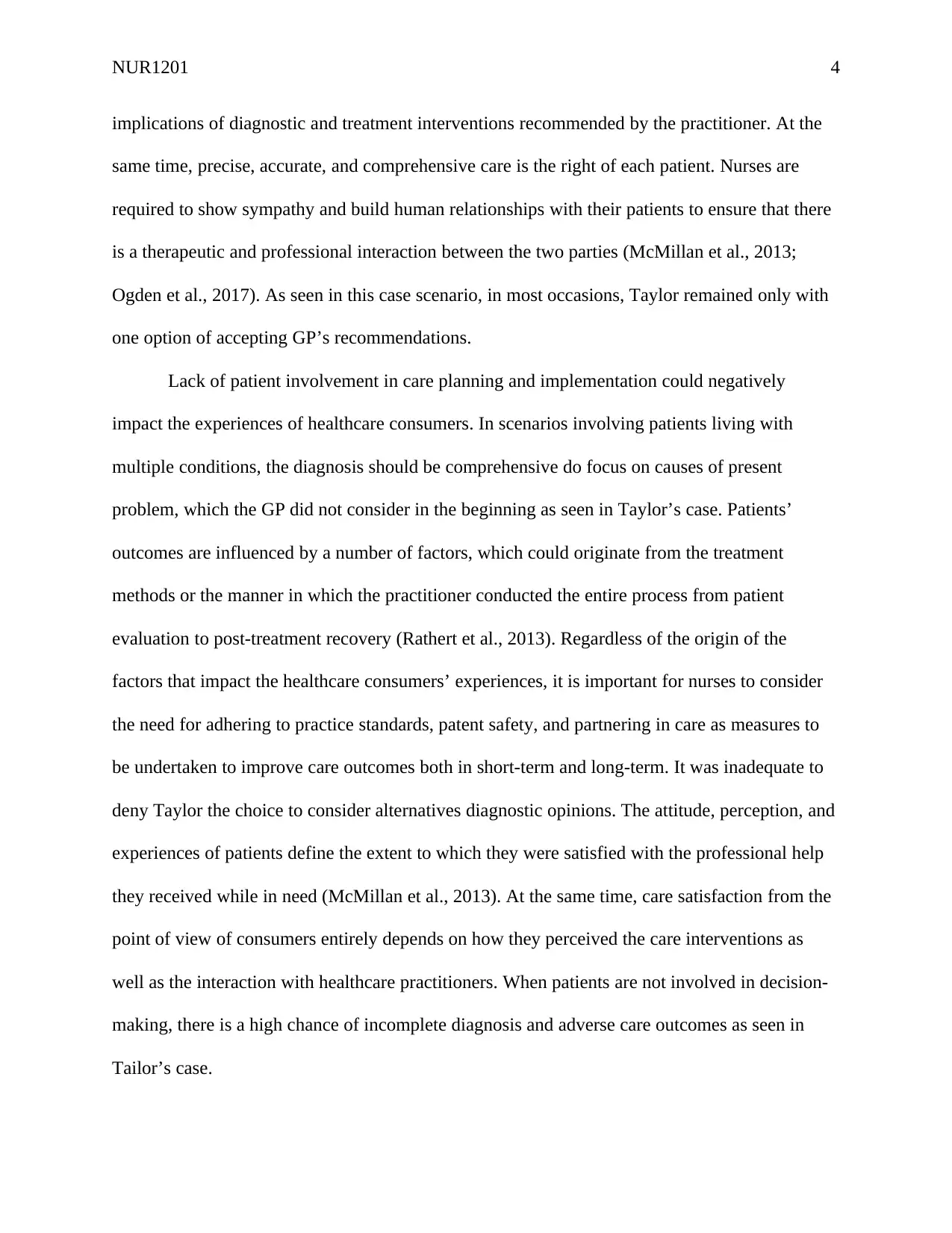
NUR1201 4
implications of diagnostic and treatment interventions recommended by the practitioner. At the
same time, precise, accurate, and comprehensive care is the right of each patient. Nurses are
required to show sympathy and build human relationships with their patients to ensure that there
is a therapeutic and professional interaction between the two parties (McMillan et al., 2013;
Ogden et al., 2017). As seen in this case scenario, in most occasions, Taylor remained only with
one option of accepting GP’s recommendations.
Lack of patient involvement in care planning and implementation could negatively
impact the experiences of healthcare consumers. In scenarios involving patients living with
multiple conditions, the diagnosis should be comprehensive do focus on causes of present
problem, which the GP did not consider in the beginning as seen in Taylor’s case. Patients’
outcomes are influenced by a number of factors, which could originate from the treatment
methods or the manner in which the practitioner conducted the entire process from patient
evaluation to post-treatment recovery (Rathert et al., 2013). Regardless of the origin of the
factors that impact the healthcare consumers’ experiences, it is important for nurses to consider
the need for adhering to practice standards, patent safety, and partnering in care as measures to
be undertaken to improve care outcomes both in short-term and long-term. It was inadequate to
deny Taylor the choice to consider alternatives diagnostic opinions. The attitude, perception, and
experiences of patients define the extent to which they were satisfied with the professional help
they received while in need (McMillan et al., 2013). At the same time, care satisfaction from the
point of view of consumers entirely depends on how they perceived the care interventions as
well as the interaction with healthcare practitioners. When patients are not involved in decision-
making, there is a high chance of incomplete diagnosis and adverse care outcomes as seen in
Tailor’s case.
implications of diagnostic and treatment interventions recommended by the practitioner. At the
same time, precise, accurate, and comprehensive care is the right of each patient. Nurses are
required to show sympathy and build human relationships with their patients to ensure that there
is a therapeutic and professional interaction between the two parties (McMillan et al., 2013;
Ogden et al., 2017). As seen in this case scenario, in most occasions, Taylor remained only with
one option of accepting GP’s recommendations.
Lack of patient involvement in care planning and implementation could negatively
impact the experiences of healthcare consumers. In scenarios involving patients living with
multiple conditions, the diagnosis should be comprehensive do focus on causes of present
problem, which the GP did not consider in the beginning as seen in Taylor’s case. Patients’
outcomes are influenced by a number of factors, which could originate from the treatment
methods or the manner in which the practitioner conducted the entire process from patient
evaluation to post-treatment recovery (Rathert et al., 2013). Regardless of the origin of the
factors that impact the healthcare consumers’ experiences, it is important for nurses to consider
the need for adhering to practice standards, patent safety, and partnering in care as measures to
be undertaken to improve care outcomes both in short-term and long-term. It was inadequate to
deny Taylor the choice to consider alternatives diagnostic opinions. The attitude, perception, and
experiences of patients define the extent to which they were satisfied with the professional help
they received while in need (McMillan et al., 2013). At the same time, care satisfaction from the
point of view of consumers entirely depends on how they perceived the care interventions as
well as the interaction with healthcare practitioners. When patients are not involved in decision-
making, there is a high chance of incomplete diagnosis and adverse care outcomes as seen in
Tailor’s case.
Paraphrase This Document
Need a fresh take? Get an instant paraphrase of this document with our AI Paraphraser
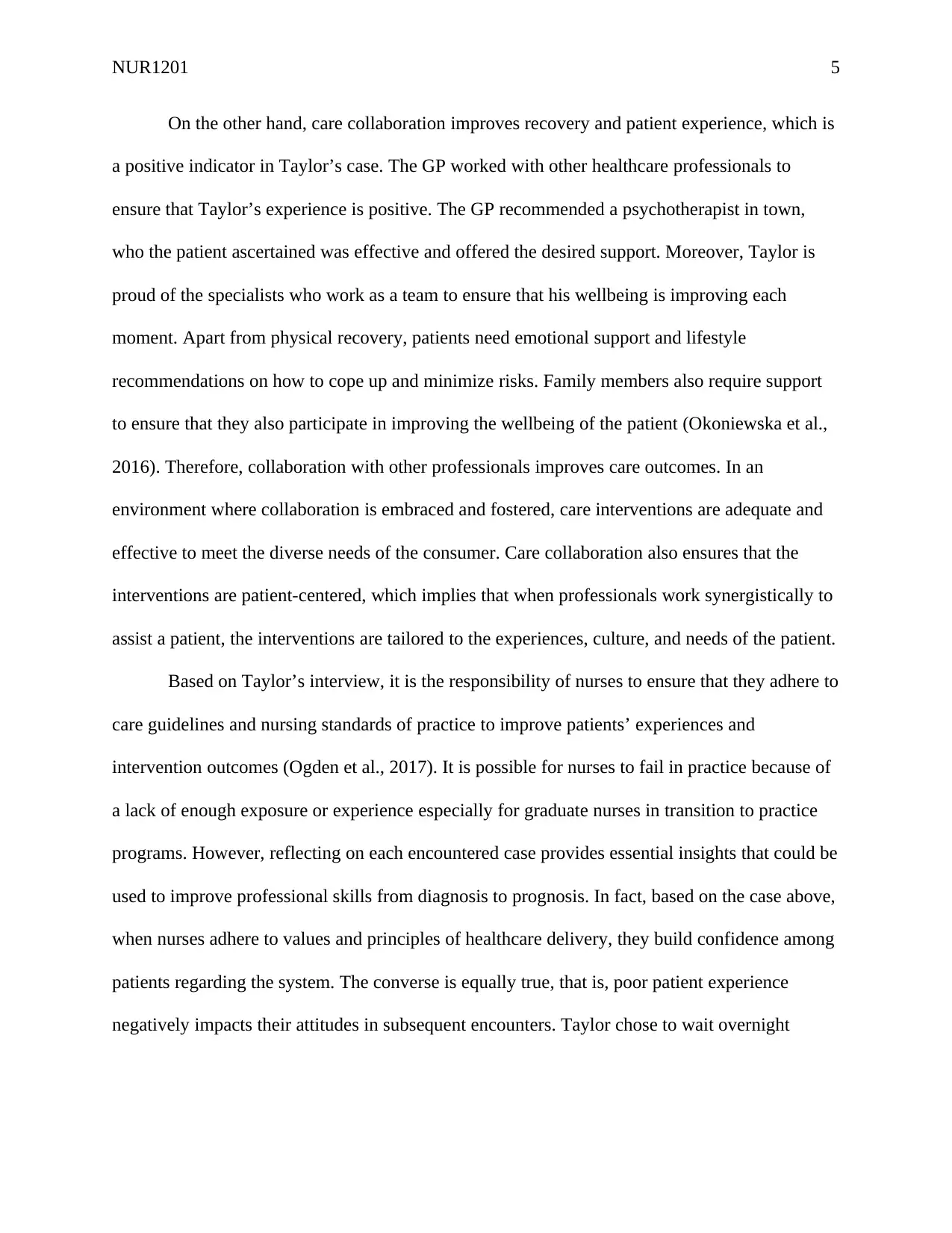
NUR1201 5
On the other hand, care collaboration improves recovery and patient experience, which is
a positive indicator in Taylor’s case. The GP worked with other healthcare professionals to
ensure that Taylor’s experience is positive. The GP recommended a psychotherapist in town,
who the patient ascertained was effective and offered the desired support. Moreover, Taylor is
proud of the specialists who work as a team to ensure that his wellbeing is improving each
moment. Apart from physical recovery, patients need emotional support and lifestyle
recommendations on how to cope up and minimize risks. Family members also require support
to ensure that they also participate in improving the wellbeing of the patient (Okoniewska et al.,
2016). Therefore, collaboration with other professionals improves care outcomes. In an
environment where collaboration is embraced and fostered, care interventions are adequate and
effective to meet the diverse needs of the consumer. Care collaboration also ensures that the
interventions are patient-centered, which implies that when professionals work synergistically to
assist a patient, the interventions are tailored to the experiences, culture, and needs of the patient.
Based on Taylor’s interview, it is the responsibility of nurses to ensure that they adhere to
care guidelines and nursing standards of practice to improve patients’ experiences and
intervention outcomes (Ogden et al., 2017). It is possible for nurses to fail in practice because of
a lack of enough exposure or experience especially for graduate nurses in transition to practice
programs. However, reflecting on each encountered case provides essential insights that could be
used to improve professional skills from diagnosis to prognosis. In fact, based on the case above,
when nurses adhere to values and principles of healthcare delivery, they build confidence among
patients regarding the system. The converse is equally true, that is, poor patient experience
negatively impacts their attitudes in subsequent encounters. Taylor chose to wait overnight
On the other hand, care collaboration improves recovery and patient experience, which is
a positive indicator in Taylor’s case. The GP worked with other healthcare professionals to
ensure that Taylor’s experience is positive. The GP recommended a psychotherapist in town,
who the patient ascertained was effective and offered the desired support. Moreover, Taylor is
proud of the specialists who work as a team to ensure that his wellbeing is improving each
moment. Apart from physical recovery, patients need emotional support and lifestyle
recommendations on how to cope up and minimize risks. Family members also require support
to ensure that they also participate in improving the wellbeing of the patient (Okoniewska et al.,
2016). Therefore, collaboration with other professionals improves care outcomes. In an
environment where collaboration is embraced and fostered, care interventions are adequate and
effective to meet the diverse needs of the consumer. Care collaboration also ensures that the
interventions are patient-centered, which implies that when professionals work synergistically to
assist a patient, the interventions are tailored to the experiences, culture, and needs of the patient.
Based on Taylor’s interview, it is the responsibility of nurses to ensure that they adhere to
care guidelines and nursing standards of practice to improve patients’ experiences and
intervention outcomes (Ogden et al., 2017). It is possible for nurses to fail in practice because of
a lack of enough exposure or experience especially for graduate nurses in transition to practice
programs. However, reflecting on each encountered case provides essential insights that could be
used to improve professional skills from diagnosis to prognosis. In fact, based on the case above,
when nurses adhere to values and principles of healthcare delivery, they build confidence among
patients regarding the system. The converse is equally true, that is, poor patient experience
negatively impacts their attitudes in subsequent encounters. Taylor chose to wait overnight
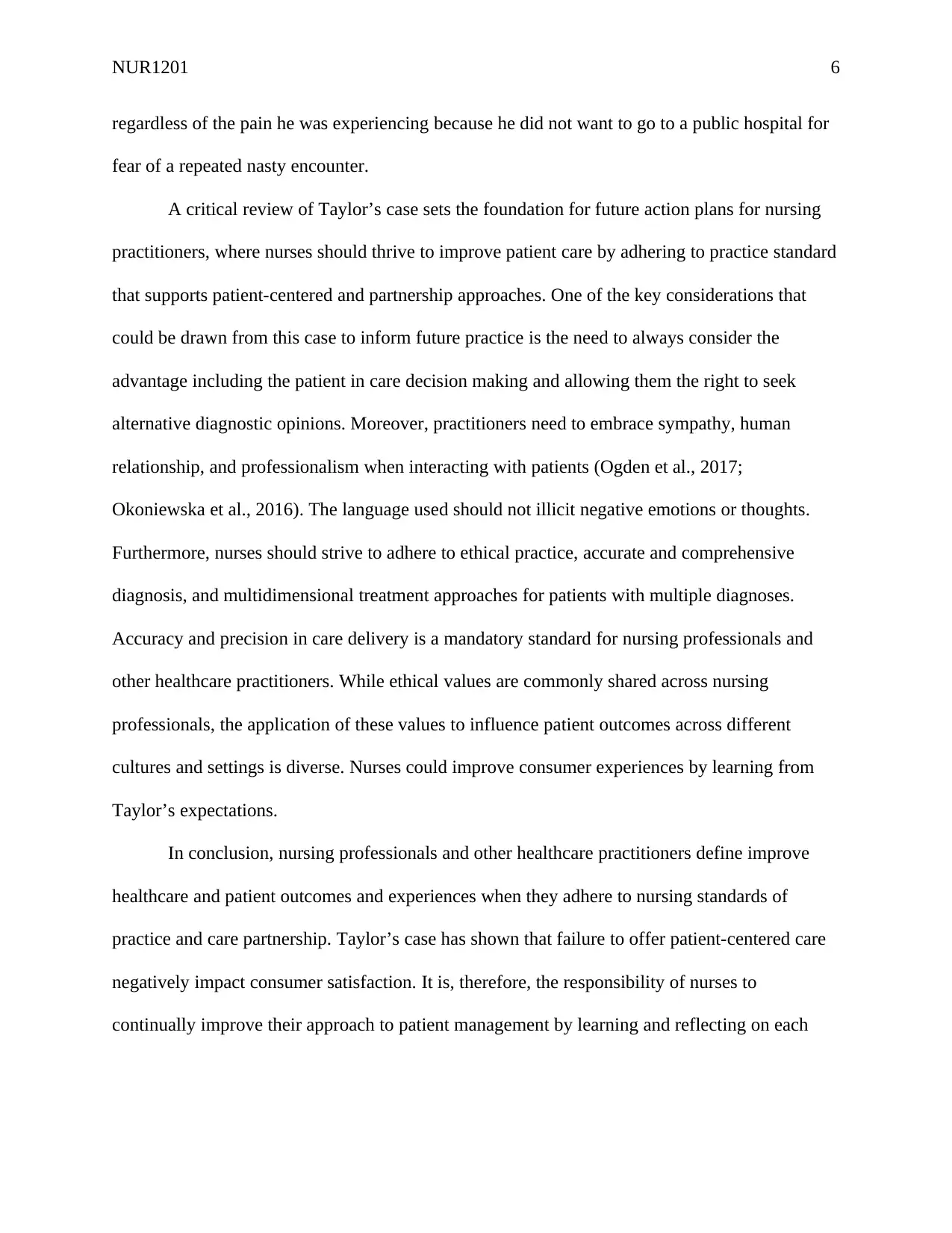
NUR1201 6
regardless of the pain he was experiencing because he did not want to go to a public hospital for
fear of a repeated nasty encounter.
A critical review of Taylor’s case sets the foundation for future action plans for nursing
practitioners, where nurses should thrive to improve patient care by adhering to practice standard
that supports patient-centered and partnership approaches. One of the key considerations that
could be drawn from this case to inform future practice is the need to always consider the
advantage including the patient in care decision making and allowing them the right to seek
alternative diagnostic opinions. Moreover, practitioners need to embrace sympathy, human
relationship, and professionalism when interacting with patients (Ogden et al., 2017;
Okoniewska et al., 2016). The language used should not illicit negative emotions or thoughts.
Furthermore, nurses should strive to adhere to ethical practice, accurate and comprehensive
diagnosis, and multidimensional treatment approaches for patients with multiple diagnoses.
Accuracy and precision in care delivery is a mandatory standard for nursing professionals and
other healthcare practitioners. While ethical values are commonly shared across nursing
professionals, the application of these values to influence patient outcomes across different
cultures and settings is diverse. Nurses could improve consumer experiences by learning from
Taylor’s expectations.
In conclusion, nursing professionals and other healthcare practitioners define improve
healthcare and patient outcomes and experiences when they adhere to nursing standards of
practice and care partnership. Taylor’s case has shown that failure to offer patient-centered care
negatively impact consumer satisfaction. It is, therefore, the responsibility of nurses to
continually improve their approach to patient management by learning and reflecting on each
regardless of the pain he was experiencing because he did not want to go to a public hospital for
fear of a repeated nasty encounter.
A critical review of Taylor’s case sets the foundation for future action plans for nursing
practitioners, where nurses should thrive to improve patient care by adhering to practice standard
that supports patient-centered and partnership approaches. One of the key considerations that
could be drawn from this case to inform future practice is the need to always consider the
advantage including the patient in care decision making and allowing them the right to seek
alternative diagnostic opinions. Moreover, practitioners need to embrace sympathy, human
relationship, and professionalism when interacting with patients (Ogden et al., 2017;
Okoniewska et al., 2016). The language used should not illicit negative emotions or thoughts.
Furthermore, nurses should strive to adhere to ethical practice, accurate and comprehensive
diagnosis, and multidimensional treatment approaches for patients with multiple diagnoses.
Accuracy and precision in care delivery is a mandatory standard for nursing professionals and
other healthcare practitioners. While ethical values are commonly shared across nursing
professionals, the application of these values to influence patient outcomes across different
cultures and settings is diverse. Nurses could improve consumer experiences by learning from
Taylor’s expectations.
In conclusion, nursing professionals and other healthcare practitioners define improve
healthcare and patient outcomes and experiences when they adhere to nursing standards of
practice and care partnership. Taylor’s case has shown that failure to offer patient-centered care
negatively impact consumer satisfaction. It is, therefore, the responsibility of nurses to
continually improve their approach to patient management by learning and reflecting on each
⊘ This is a preview!⊘
Do you want full access?
Subscribe today to unlock all pages.

Trusted by 1+ million students worldwide

NUR1201 7
encounter or experience. This assignment has shown that patient-centered and collaborative care
is central to improved outcomes for any treatment intervention.
encounter or experience. This assignment has shown that patient-centered and collaborative care
is central to improved outcomes for any treatment intervention.
Paraphrase This Document
Need a fresh take? Get an instant paraphrase of this document with our AI Paraphraser
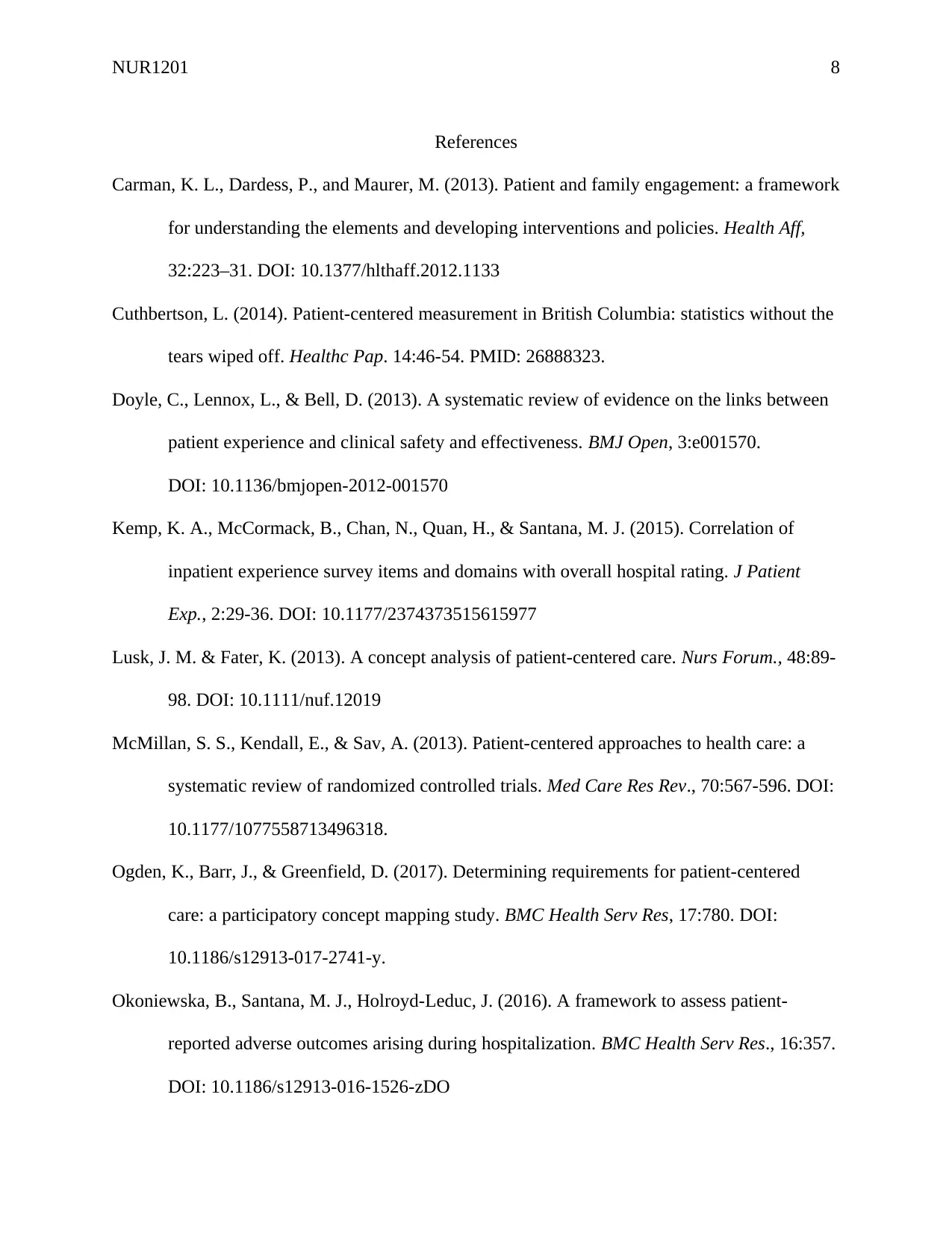
NUR1201 8
References
Carman, K. L., Dardess, P., and Maurer, M. (2013). Patient and family engagement: a framework
for understanding the elements and developing interventions and policies. Health Aff,
32:223–31. DOI: 10.1377/hlthaff.2012.1133
Cuthbertson, L. (2014). Patient-centered measurement in British Columbia: statistics without the
tears wiped off. Healthc Pap. 14:46-54. PMID: 26888323.
Doyle, C., Lennox, L., & Bell, D. (2013). A systematic review of evidence on the links between
patient experience and clinical safety and effectiveness. BMJ Open, 3:e001570.
DOI: 10.1136/bmjopen-2012-001570
Kemp, K. A., McCormack, B., Chan, N., Quan, H., & Santana, M. J. (2015). Correlation of
inpatient experience survey items and domains with overall hospital rating. J Patient
Exp., 2:29-36. DOI: 10.1177/2374373515615977
Lusk, J. M. & Fater, K. (2013). A concept analysis of patient-centered care. Nurs Forum., 48:89-
98. DOI: 10.1111/nuf.12019
McMillan, S. S., Kendall, E., & Sav, A. (2013). Patient-centered approaches to health care: a
systematic review of randomized controlled trials. Med Care Res Rev., 70:567-596. DOI:
10.1177/1077558713496318.
Ogden, K., Barr, J., & Greenfield, D. (2017). Determining requirements for patient-centered
care: a participatory concept mapping study. BMC Health Serv Res, 17:780. DOI:
10.1186/s12913-017-2741-y.
Okoniewska, B., Santana, M. J., Holroyd-Leduc, J. (2016). A framework to assess patient-
reported adverse outcomes arising during hospitalization. BMC Health Serv Res., 16:357.
DOI: 10.1186/s12913-016-1526-zDO
References
Carman, K. L., Dardess, P., and Maurer, M. (2013). Patient and family engagement: a framework
for understanding the elements and developing interventions and policies. Health Aff,
32:223–31. DOI: 10.1377/hlthaff.2012.1133
Cuthbertson, L. (2014). Patient-centered measurement in British Columbia: statistics without the
tears wiped off. Healthc Pap. 14:46-54. PMID: 26888323.
Doyle, C., Lennox, L., & Bell, D. (2013). A systematic review of evidence on the links between
patient experience and clinical safety and effectiveness. BMJ Open, 3:e001570.
DOI: 10.1136/bmjopen-2012-001570
Kemp, K. A., McCormack, B., Chan, N., Quan, H., & Santana, M. J. (2015). Correlation of
inpatient experience survey items and domains with overall hospital rating. J Patient
Exp., 2:29-36. DOI: 10.1177/2374373515615977
Lusk, J. M. & Fater, K. (2013). A concept analysis of patient-centered care. Nurs Forum., 48:89-
98. DOI: 10.1111/nuf.12019
McMillan, S. S., Kendall, E., & Sav, A. (2013). Patient-centered approaches to health care: a
systematic review of randomized controlled trials. Med Care Res Rev., 70:567-596. DOI:
10.1177/1077558713496318.
Ogden, K., Barr, J., & Greenfield, D. (2017). Determining requirements for patient-centered
care: a participatory concept mapping study. BMC Health Serv Res, 17:780. DOI:
10.1186/s12913-017-2741-y.
Okoniewska, B., Santana, M. J., Holroyd-Leduc, J. (2016). A framework to assess patient-
reported adverse outcomes arising during hospitalization. BMC Health Serv Res., 16:357.
DOI: 10.1186/s12913-016-1526-zDO
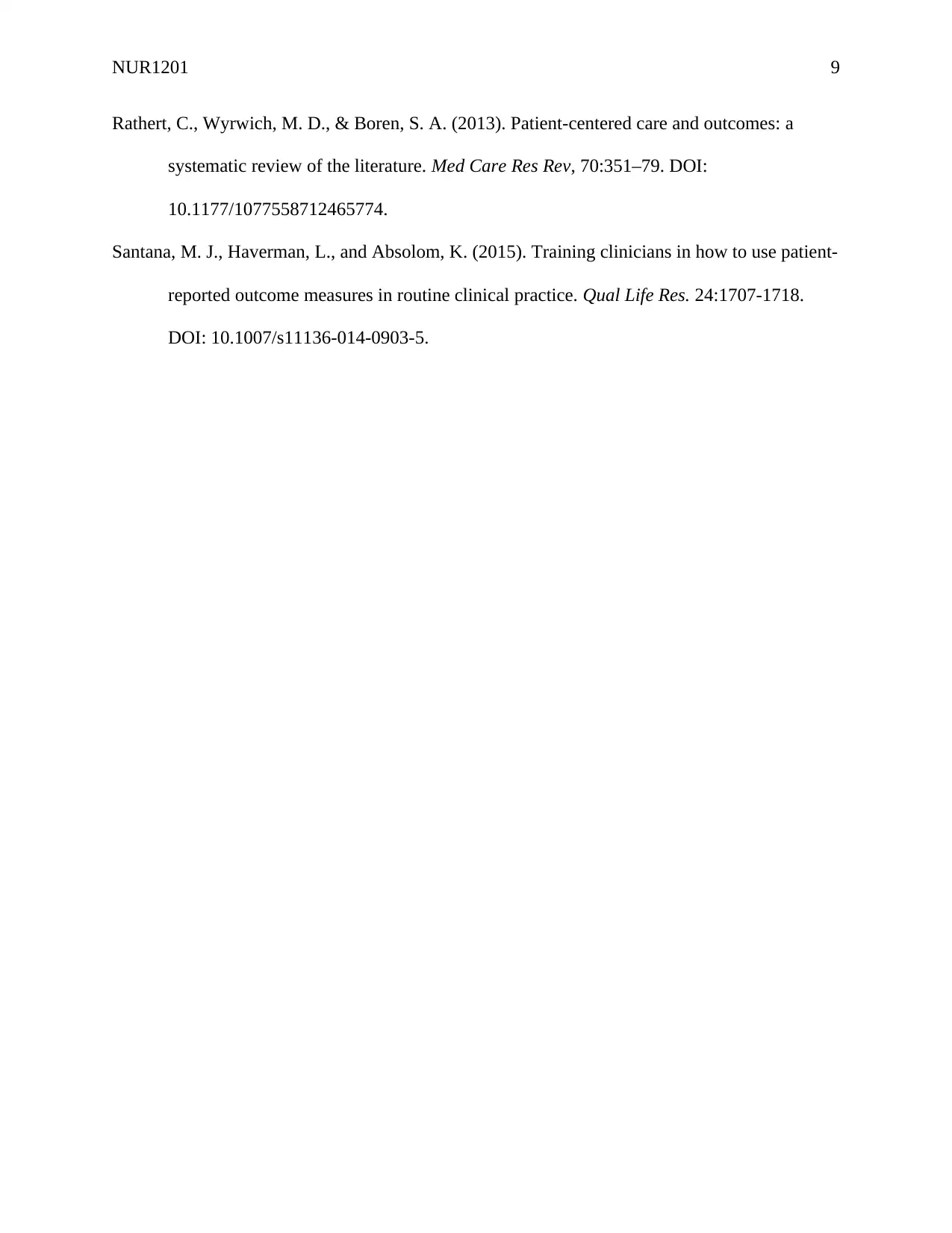
NUR1201 9
Rathert, C., Wyrwich, M. D., & Boren, S. A. (2013). Patient-centered care and outcomes: a
systematic review of the literature. Med Care Res Rev, 70:351–79. DOI:
10.1177/1077558712465774.
Santana, M. J., Haverman, L., and Absolom, K. (2015). Training clinicians in how to use patient-
reported outcome measures in routine clinical practice. Qual Life Res. 24:1707-1718.
DOI: 10.1007/s11136-014-0903-5.
Rathert, C., Wyrwich, M. D., & Boren, S. A. (2013). Patient-centered care and outcomes: a
systematic review of the literature. Med Care Res Rev, 70:351–79. DOI:
10.1177/1077558712465774.
Santana, M. J., Haverman, L., and Absolom, K. (2015). Training clinicians in how to use patient-
reported outcome measures in routine clinical practice. Qual Life Res. 24:1707-1718.
DOI: 10.1007/s11136-014-0903-5.
⊘ This is a preview!⊘
Do you want full access?
Subscribe today to unlock all pages.

Trusted by 1+ million students worldwide
1 out of 9
Related Documents
Your All-in-One AI-Powered Toolkit for Academic Success.
+13062052269
info@desklib.com
Available 24*7 on WhatsApp / Email
![[object Object]](/_next/static/media/star-bottom.7253800d.svg)
Unlock your academic potential
Copyright © 2020–2025 A2Z Services. All Rights Reserved. Developed and managed by ZUCOL.





